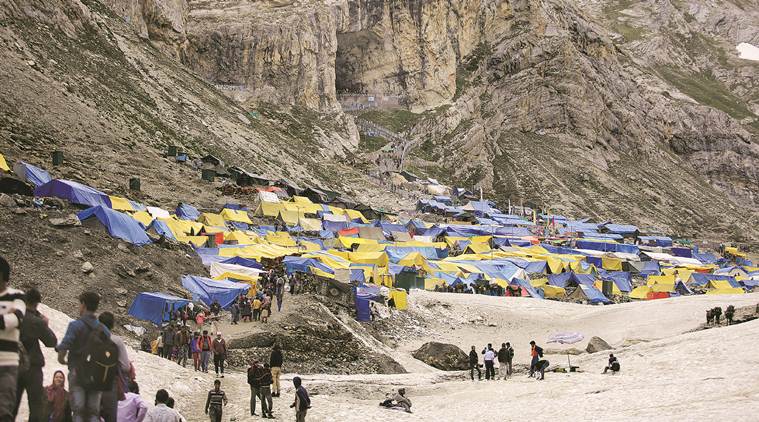 At the summit, three tents have been damaged by the wind, another torn by a bear. (Photo: Praveen Khanna)
At the summit, three tents have been damaged by the wind, another torn by a bear. (Photo: Praveen Khanna)
More than 400 doctors and other health professionals had been trained for high-altitude medical emergencies by the Health Department for this year’s Amarnath Yatra. One doctor and four other health professionals were sent to Mahagun’s Top — at 14,500 feet, the highest peak on the yatra route.
The oxygen levels had dipped to dangerous levels as the medical staff arrived amid six-foot snow. The team soon beat a retreat — they could not cope with the extreme conditions.
Now, only one doctor and two medical staffers remain.
“The medical team had come from Delhi, Jammu and Lucknow two days ago. All of them vomited and developed hypothermia (serious medical condition after being in severe cold). They had even requested the chief medical officer at Anantnag for a transfer from the camp,” said Dr Mustaq Ahmad Magray (37), the medical officer at Mahagun’s Top.
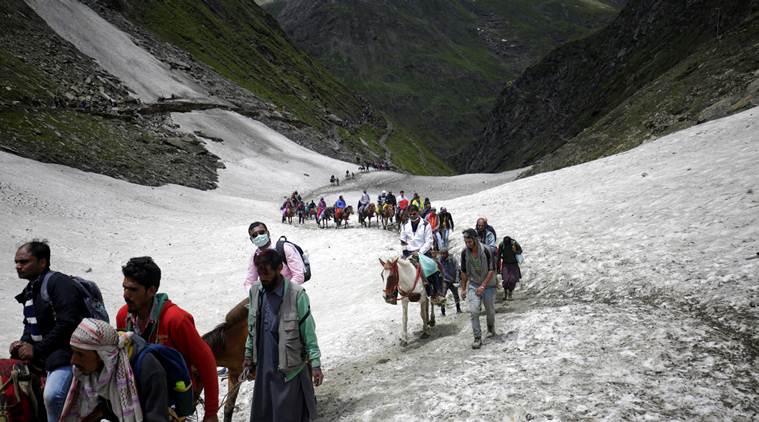 Pilgrims make their way to Sheshnag on the Amarnath Yatra. (Photo: Praveen Khanna)
Pilgrims make their way to Sheshnag on the Amarnath Yatra. (Photo: Praveen Khanna)
Two days after the medical staff took ill, the rain had cleared and snowfall had stopped on Mahagun’s Top on Tuesday. The pilgrims at Sheshnag base camp finally got the clearance by road-opening parties to commence the journey. With many of them desperate to make a dash towards the holy cave shrine, an overwhelming majority have taken ponies to pass through Mahagun’s Top. Even though the trek is not arduous in comparison to Pissu Top, the lack of oxygen is telling.
According to Amarnath Shrine board officials, seven people have died during the yatra so far this year due to different reasons. Thota Radhnam, 75, from Fiwalayam in Andhra Pradesh and Rasha Krishna Sastry died of suspected cardiac arrest at Baltal and the cave shrine, respectively. Pushkar Joshi died after he was hit by a stone near between Brarimarg and Railpathri on Monday, officials said.
“Madan Kesira Joshi from Uttarakhand and Syed Mohammad Khan, a palanquin bearer, (also) died. A woman, Navi Ben Parmar, from Gujarat and a BSF officer also died,” the official said.
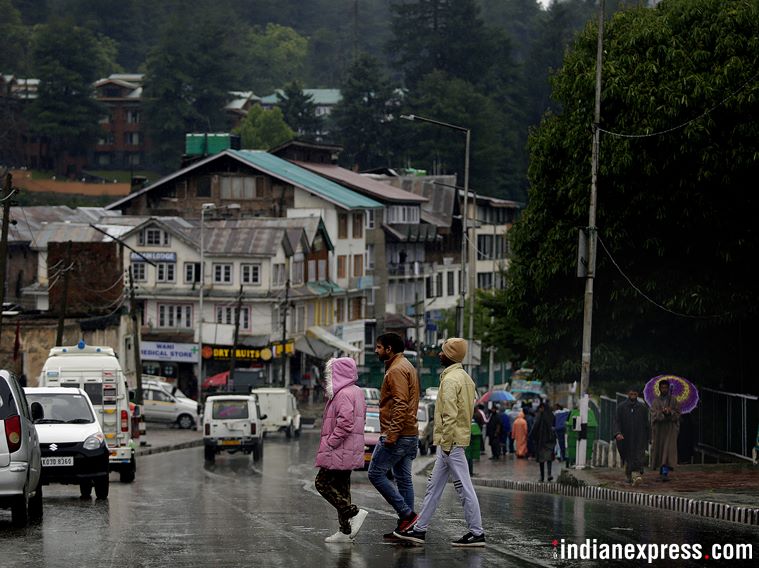 Pilgrims roaming around Pahalgam city as pilgrims of Amarnath Yatra were stranded in the yatra’s base camp at Nunwan. (Express photo by Praveen Khanna)
Pilgrims roaming around Pahalgam city as pilgrims of Amarnath Yatra were stranded in the yatra’s base camp at Nunwan. (Express photo by Praveen Khanna)
Last year, at least 25 people died of breathlessness and heart attack. This year, with the retreat of the medical team, Dr Magray and his team of one pharmacist and a nursing attendant are the first line of defence. His team is equipped with 25 oxygen cylinders, one oxygen concentrator, which can produce oxygen, oximetry machine to ascertain oxygen saturation of a patient, and a hypo bag, used to revive a patient with severe case of breathlessness in 15 seconds.
He has a new addition to his kit: a defibrillator.
“Last year, a magistrate had of cardiac arrest,” Dr Magray recalled. “We also have an ECG machine. We have been asking for an additional oxygen concentrator from Sheshnag base camp.”
The medical staff on Mahagun’s Top attend to more than 50 patients each day during the peak of the yatra each year. Most pilgrims who choose to cover the entire Pahalgam route in two days suffered from breathlessness due to lack of acclimatisation, dyspepsia, as the pilgrims chose to have heavy breakfast, leading to indigestion and high fever, headache, vomiting, and hypothermia.
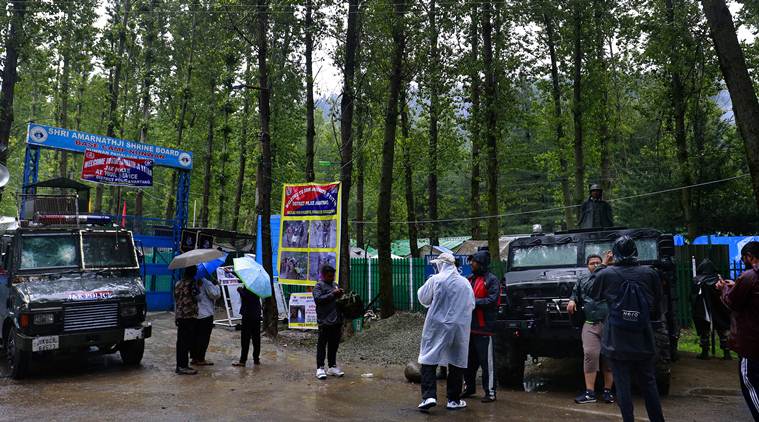 At Nunwan base camp in Pahalgam on Thursday. (Photo: Praveen Khanna)
At Nunwan base camp in Pahalgam on Thursday. (Photo: Praveen Khanna)
But this year, having been stranded at Sheshnag base camp, pilgrims have taken ponies to make a dash for the shrine. As the trek began, those who chose to walk were soon out of breath. Those on ponies navigated through the steep ascent through rocks, ice-cold water flooding their path as the lush green mountains of Sheshnag gave way to the naked mountains of Mahagun’s Top.
At the summit, the 20-man team from the SDRF was busy clearing the snow. Three tents were damaged by high-speed wind, and another torn by a bear indigenous to south Kashmir Himalayas.
Every night, officers from J&K Armed Police and SDRF wake up gasping for breath.
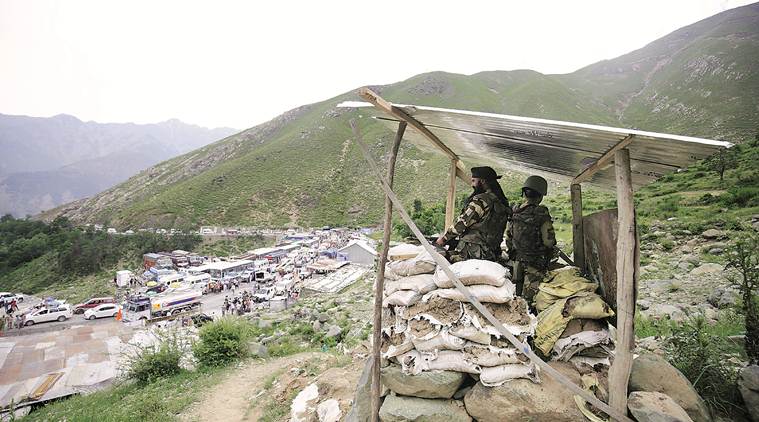 Security personnel stand guard as the Amarnath Yatra begins, in Banihal. (Photo: Praveen Khanna)
Security personnel stand guard as the Amarnath Yatra begins, in Banihal. (Photo: Praveen Khanna)
The oxygen levels dip to dangerously low levels and the men said feel suffocated in their sleep. “The patient feels like his lungs are collapsing. After the suffocation at night they have to open their tents for air circulation and suffer the cold wind,” Dr Magray said.
The only source of electricity are two 2.8 kv generators, and an inflatable light provides a light source with a radius of 200 metres. However, with the generators barely able to function in the cold, those on Mahagun’s Top depend on two officers from the Forest Department to make bonfires to keep them warm. Abdul Rahman has already burnt 2 quintals of firewood to keep the campsite warm. The fir trees from Chandanwari and Pahalgam are used to make the fire. “We use trees which have already fallen, and there are quite a few of them,” Abdul said.
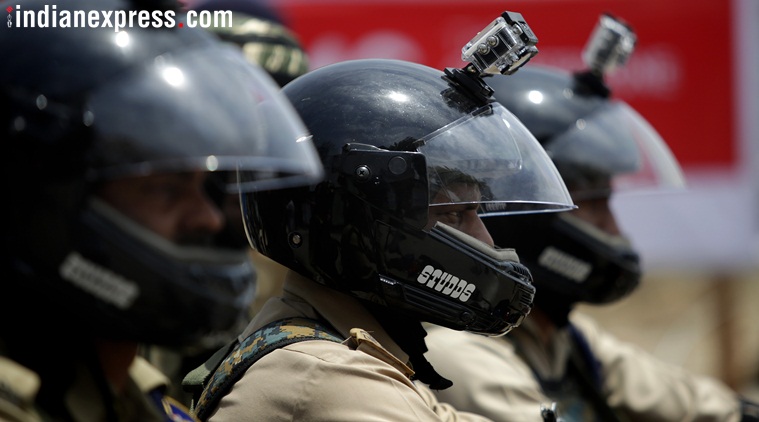 Special CRPF motorcycle squad deployed to protect Pilgrims of Amarnath Yatra at Amarnath Yatra base camp in Jammu. (Express Photo by Praveen Khanna/File)
Special CRPF motorcycle squad deployed to protect Pilgrims of Amarnath Yatra at Amarnath Yatra base camp in Jammu. (Express Photo by Praveen Khanna/File)
As the pilgrims passed through Mahagun’s Top, they did not visit Dr Magray’s tent, as none stayed at the summit for more than five minutes, making their descent towards Panchtarni camp. The pilgrims cut across base camp surrounded by lush green fields as private helicopters hovered above them, resuming flight operations after three days of rain.
Climbing through a narrow passageway, they finally enter the holy shrine cave base camp.